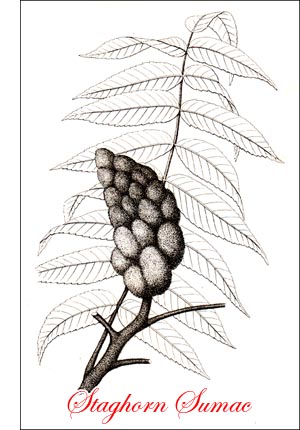Sumachs and Smoke Tree
 FAMILY ANACARDIACEAE
FAMILY ANACARDIACEAEGenus RHUS, Linn.
Small trees or shrubs with stout, pithy branchlets, and viscid, usually milky, juice. Leaves alternate, usually pinnately compound. Flowers minute, greenish, polygamo-dioecious, in compound panicles. Fruit a small, dry drupe.
The sumachs form a temperate zone genus of a great tropical family, comprising fifty genera and 400 species. There are about 120 species of the genus Rhus; they are most abundant in South Africa. Sixteen species are found in North America, only four of which are ever trees. Of these, none compare in economic importance with the sumach cultivated in southern Europe, whose leaves contain 25 to 30 per cent. of tannic acid, and are regularly gathered and dried, and used in the tanning of fine leathers.
The pistachio-nut tree, from Asia Minor, now cultivated in southern California, is a relative of our roadside sumachs, as is also the turpentine tree of southern Europe. They belong to the genus Pistacia, and are both commercially important.
The Japanese lacquer tree (Rhus vernicifera, DC.) exceeds all other species in value; its sap is the black varnish used in making lacquered wares. Each year about 130,000 gallons of this valuable substance are gathered in Japan and China. Each little tree yields but a few ounces, and is killed by the draining process. The acrid juice of R. Vernix, our poison sumach, is milky and turns black on exposure to the air, forming a substance very much like the lacquer varnish.
American Smoke Tree
Dwarf Sumach or Mountain Sumach Tree
Poison Sumach Tree
Poison Wood or Hog Gum Tree
Smooth Sumach Tree
Staghorn Sumach or Hairy Sumach Tree
Western Sumach or Mahogany Tree